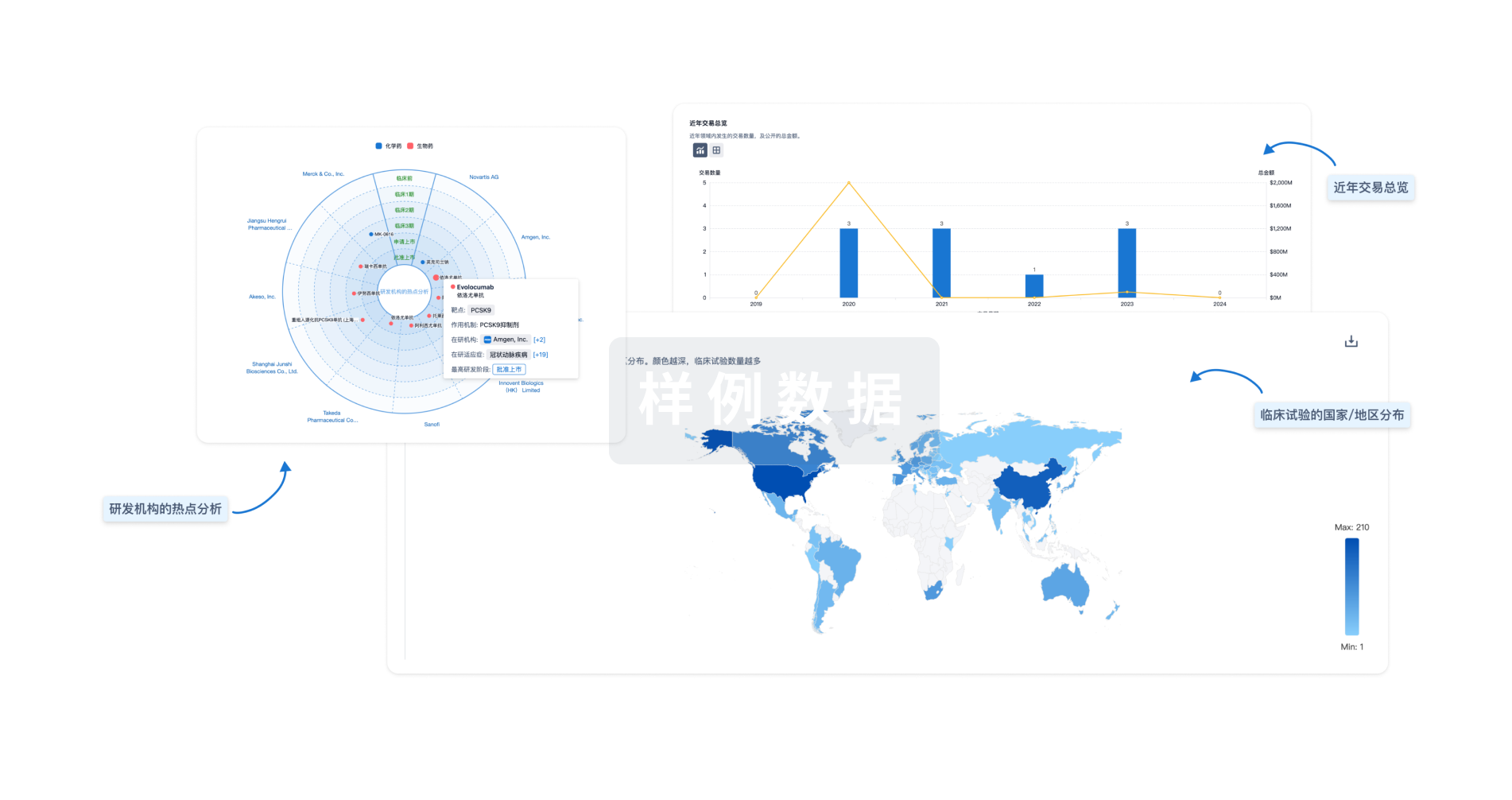预约演示
更新于:2025-05-07
CFD
更新于:2025-05-07
基本信息
别名 Adipsin、ADN、C3 convertase activator + [8] |
简介 Factor D cleaves factor B when the latter is complexed with factor C3b, activating the C3bbb complex, which then becomes the C3 convertase of the alternate pathway. Its function is homologous to that of C1s in the classical pathway. |
关联
22
项与 CFD 相关的药物靶点 |
作用机制 CFD抑制剂 |
在研适应症 |
最高研发阶段批准上市 |
首次获批国家/地区 日本 |
首次获批日期2024-01-18 |
靶点 |
作用机制 CFD抑制剂 |
在研适应症 |
最高研发阶段临床2期 |
首次获批国家/地区- |
首次获批日期1800-01-20 |
靶点 |
作用机制 CFD抑制剂 |
在研适应症- |
非在研适应症- |
最高研发阶段临床1期 |
首次获批国家/地区- |
首次获批日期1800-01-20 |
71
项与 CFD 相关的临床试验NCT06449001
A Phase 3 Open-Label Study of Danicopan as Add-on Treatment to Ravulizumab or Eculizumab in Pediatric Participants With Paroxysmal Nocturnal Hemoglobinuria Who Have Clinically Significant Extravascular Hemolysis
The primary objective of this study is to evaluate efficacy of danicopan as add-on treatment to ravulizumab or eculizumab as assessed by hemoglobin (Hgb) change from Baseline at Week 12 in pediatric participants with paroxysmal nocturnal hemoglobinuria (PNH) and clinically significant extravascular hemolysis (CS-EVH).
开始日期2025-02-28 |
CTR20232195
一项在增生性狼疮性肾炎 (LN) 或免疫球蛋白 A 肾病 (IgAN) 成人受试者中评估 ALXN2050 的疗效和安全性的 II 期、随机、双盲、安慰剂对照、剂量探索研究
ALXN2050 是一种强效、可逆口服小分子 D 因子 (FD) 抑制剂,是补体旁路途径 (AP) 的重要组成部分。补体系统参与增生性 LN 和 免疫球蛋白A肾病 (IgAN) 的病理生理学过程。本研究的目的是评估口服 ALXN2050 与安慰剂相比的疗效和安全性,证明对 FD 抑制有效性的概念验证,并确定解决接受背景标准疗法治疗的 LN 或 IgAN 患者的未满足医疗需求的有效剂量。
开始日期2024-03-11 |
申办/合作机构 Catalent CTS, Inc. [+6] |
NCT06071442
A Three-Part Phase 1 Study to Evaluate the Potential Drug-Drug Interactions Between Vemircopan and Rosuvastatin, Metformin, Levonorgestrel-Ethinyl Estradiol-Containing Oral Contraceptives, and Carbamazepine in Healthy Adult Participants
This study will investigate the potential drug interactions between vemircopan and metformin, rosuvastatin, levonorgestrel/ ethinyl estradiol (LNG/EE)-containing oral contraceptive(s) (OCs), and carbamazepine in healthy participants.
开始日期2024-01-17 |
100 项与 CFD 相关的临床结果
登录后查看更多信息
100 项与 CFD 相关的转化医学
登录后查看更多信息
0 项与 CFD 相关的专利(医药)
登录后查看更多信息
1,449
项与 CFD 相关的文献(医药)2025-05-01·Thrombosis Research
Phenotype, genotype, and laboratory assessment of congenital fibrinogen disorders: Data from the Rare Bleeding disorders in the Netherlands study
Article
作者: van Heerde, Waander L ; den Exter, Paul L ; Meijer, Karina ; Rijpma, Sanna R ; Saes, Joline L ; Haisma, Bauke ; Schols, Saskia E M ; van Es, Nick ; Nieuwenhuizen, Laurens ; Cnossen, Marjon H ; Kruis, Ilmar C ; Blijlevens, Nicole M A
2025-05-01·Artificial Organs
Article
作者: Palazzolo, Alan ; Giridharan, Guruprasad ; Afaq, Muhammad ; Rodefeld, Mark ; Ghali, George ; Sarfare, Shreyas
2025-04-25·Science
Bottom-up reconstruction of functional death fold signalosomes reveals a requirement for polymer stability and avidity
Article
作者: Lobnow, Finn ; Taylor, Marcus J. ; Ziska, Elke ; Dirvanskyte, Paulina ; Cao, Fakun ; Halfmann, Randal ; Weyhenmeyer, Daniel ; Lichtenstein, Mauriz A. ; Kulesza, Anna
66
项与 CFD 相关的新闻(医药)2025-04-28
·抗体圈
这篇文章于2017年发表在Organic Process Research & Development。该文章是由辉瑞科学家根据内部案例对ADC药物后期工艺开发策略的总结。摘要:随着抗体药物偶联物(ADC)从临床开发阶段进入关键研究阶段,在临床疗效和适当安全性的支持下,开发后期和商业化的工艺和方法成为当务之急。在早期流程的开发过程中,重点是速度、一致性和质量。对于后期开发,需要考虑其他方面,包括工艺稳健性、成本效益、工艺和方法可转移性,以及作为监管备案基础的综合控制策略。【NO.1】研究背景抗体药物偶联物(ADC)的后期开发可能由许多因素触发。在常规开发计划中,ADC将经历传统的临床开发阶段,包括1期和2期。随着药物达到概念验证,通常有理由在工艺和方法开发的规划和执行方面进行大量投资,以支持3期/关键研究,然后进行工艺验证、发布和商业化生产。随着2012年突破性疗法认定的推出,在医疗需求未得到满足的疾病领域表现出疗效的早期迹象的ADC有可能直接从1a/1b期进入关键试验。当然,在加速时间表下完成所有必要的开发工作需要在多个功能单元之间进行仔细规划和协调,因为ADC涉及两种原料药中间体(DSI)、接头/有效载荷和单克隆抗体(mAb)、一种原料药 (DS)、ADC和药品(DP)。此外,监管申报需要特别考虑,并且可能涉及多个不同的模块3部分,每个主要中间体一个,一个用于原料药,一个用于药品。无论哪种情况,无论是加速药物开发还是传统药物开发,都期望在监管文件中提交完整的化学、制造和控制(CMC)部分。如今,大多数药物都是使用质量源于设计(QbD)方法开发的,旨在实现持续工艺验证(CPV)。QbD方法旨在推动对工艺和产品的深入理解。确定影响疗效和安全性的重要质量属性,并通过系统实验确定影响这些属性的工艺参数。一旦工艺在实验室规模上得到优化和建立,就会使用适当合格的缩小模型来确定制造工艺的作范围。这些研究通常涉及实验设计(DOE)和统计分析。在某些情况下,还可以确定所选参数的失效边缘。纯化步骤,例如层析和渗滤通常使用标准生物工艺方法进行优化。扩大规模和技术转移带来了特殊的挑战和机遇。需要对反应动力学、添加速率和其他参数有透彻的了解,才能正确设计和作大型偶联反应容器。必须进行详细的工艺拟合评估,以确保现有设备满足工艺要求。在将购买新设备的情况下,需要首先决定是使用一次性设备还是专用、可重复使用或多产品设备。对于专用和多产品设备,清洁验证成为一个关键考虑因素。放大、设备变更和潜在的场地变更也需要为放大和优化的工艺建立可比性。随着商业过程的发展,需要制定包括规范在内的综合控制策略,以确保通过适当控制重要过程参数来实现既定的质量属性范围。此外,还需要一种综合的监管策略,将接头、有效载荷、mAb、ADC(DS)和药品的质量属性联系起来。【NO.2】ADC的后期开发 ADC的后期开发,为关键临床试验、工艺验证、监管批准和商业化材料生产做准备,这带来了不同寻常的挑战组合。这些挑战来自几个来源:• ADC是连接大分子和小分子的多组分偶联物。根据所使用的化学成分,ADC可以是异质的,由一组密切相关的物种组成,或者当使用特定位点的技术时,具有更均匀的,每个mAb的有效载荷数量指定。• 后期开发工作旨在了解和控制影响连接子载荷分布和ADC的其他重要属性。• ADC的制造工艺步骤需要将生物制剂的水处理与小分子的溶剂处理相结合。这有时会导致意想不到的结果,尤其是在工艺针对更高浓度和放大进行优化时。• 在开发和制造过程中,必须在适当的设施中处理剧毒材料。ADC的生产涉及细胞毒性药物、反应性接头和抗体的组合。该抗体要么通过氨基酸具有内在反应性,要么经过修饰以使其具有反应性。由于抗体的多价性质,异质性可能是开发化学家需要监测的一个重要问题。根据所使用的偶联化学成分,偶联物可能从单一均相产物到相关偶联物的高度异质混合物不等。定义产品的偶联物分布由所选偶联化学决定,并在临床前和早期临床研究中确定。后期开发的挑战是优化商业流程,以保持产品质量属性并确保与早期临床阶段材料的可比性。这要求对工艺参数进行适当优化,以确保工艺始终如一地提供目标质量属性。对于复杂和异质的ADC,了解工艺参数如何影响单个偶联位点的反应性可能是一个挑战。虽然位点特异性化学反应在很大程度上消除了异质性问题,但内源性半胱氨酸和赖氨酸化学反应导致偶联物对许多位点进行了修饰。工艺中可能包括色谱纯化以减少产品异质性,尽管这些混合物可能难以制备分离。传统的蛋白质纯化主要致力于去除宿主细胞蛋白、核酸、高分子量物质和工艺相关杂质,而小分子纯化则侧重于分离独特的所需物质并去除密切相关的非产物分子。另一方面,ADC纯化可能面临控制目标产物异质性的额外挑战。ADC中的异质性在很大程度上是来自不同药物/抗体比(DAR)的偶联物种的共存。DAR通常是一个关键的质量属性,会影响安全性、有效性和稳定性。因此,色谱的目标是将异质性控制在规定的范围内。另一方面,由于mAb和接头有效载荷都是纯化的中间体,因此上游杂质不存在很大程度,而反应副产物、残留物和降解物则比生物工艺的典型情况更受关注。了解过程参数对质量属性影响的先决条件是建立对产品质量足够敏感的分析方法。在其他字段中没有直接平行的两个重要属性是共轭位点和DAR。针对不同填料的这些属性的分析将采用不同的形式。除了这些只能在偶联后存在和监测的质量属性之外,蛋白质或接头/有效载荷固有的一些质量属性可能在偶联物中被掩盖。偶联后,脱酰胺或偶联药物杂质等质量属性可能会发生变化,但又无法直接监测,因此需要制定全面的控制策略。控制策略包括了解起始材料的质量属性、偶联条件对原料药质量属性的影响(通过实验室模型系统获得)以及下游工艺中杂质的归宿和清除。成功的控制策略将证明,即使没有特异性释放测定,也能以科学合理的方式实现杂质控制。开发ADC的最后一个挑战是药物种类的高毒性。ADC中使用的药物的 IC50值(最大抑制浓度的一半)通常在低nM至pM范围内,这种毒性超出了大多数化学家的经验范围。因此,实验室工作需要严格遵守暴露和污染的程序、工程和防护设备控制。这些控制措施也必须在生产领域实施,这一要求需要专门的设施。本综述将在赖氨酸偶联ADC开发的背景下详细研究这些问题。1. Inotuzumab Ozogamicin (InO)案例研究InO是一种抗体-药物偶联物,由与抗生素卡利米星(ozogamicin)共价连接的人源化单克隆抗体(inotuzumab)组成. Inotuzu mAb选择性地结合存在于B淋巴细胞。Calicheamicin是一种有效的 enediyne细胞毒性剂,可导致DNA双链断裂,导致细胞死亡。InO与表达CD22的细胞结合,并在内化时释放卡利西霉素,从而引起细胞毒性。它目前处于急性淋巴细胞白血病(ALL)的3期临床试验中。InO被授予该适应症的突破性疗法认定。图1.inotuzumab ozogamicin(InO)的结构InO是使用常规赖氨酸偶联法生产的,其中琥珀酰亚胺基活化的 calicheamicin衍生物与inotuzumab上赖氨酸的ε-氨基反应形成共价键。InO的表示如图1所示。大约六个卡利希霉素衍生物分子与每个inotuzumab分子偶联。为InO开发稳健、可扩展和商业化的制造工艺的一个主要挑战是控制产品异质性,以确保与早期临床和毒理学材料的可比性。由于赖氨酸偶联化学的非位点特异性,InO是偶联物的异质混合物,具有不同负载的接头payloard(calicheamicin 衍生物)连接到inotuzumab 上的不同赖氨酸位点。然而,由于开发了优化的工艺条件,InO的药物负荷分布是可控且非常可重复的,并且偶联发生在优选的赖氨酸位点。在 mAb上的80多种赖氨酸中,超过90%的偶联发生在8-10个动力学优选的赖氨酸位点(抗体的每一半有4-5个)。因此,InO具有特征的负载分布和位置异构体分布。为了确保这种概况在整个后期工艺开发中的一致性,采用了一种系统和基于风险的方法来进行开发研究。首先,筛选InO的质量属性,并确定与偶联物异质性相关的属性。这些与异质性相关的质量属性包括: • 总载药量 • 药物载量分布 • 未偶联抗体 • 未偶联接头有效载荷 • 偶联赖氨酸的序列位置图2. iCE的药物负荷分布图2显示了通过成像毛细管等电聚焦(iCE)的InO药物负载分布示例。由于电荷差异,具有不同DAR的物质在电泳图中的迁移方式不同。在为上述质量属性和目标规格建立了分析测试方法后,这些质量属性用于测量工艺表征研究中产生的偶联物的异质性。下一步是评估影响这些质量属性的流程步骤。制备InO原料药的过程包括四个主要步骤:(1)inotuzumab与活化的calicheamicin 衍生物的偶联;(2)使用疏水作用色谱(HIC)纯化粗偶联物;(3)使用超滤/渗滤进行缓冲液置换;(4)配制以制备最终配制的原料药。多学科团队进行了初步风险评估,以确定可能影响InO原料药异质性的工艺参数。这些工艺参数包括:• 偶联反应:偶联pH值、时间、温度、药物起始量、助溶剂和表面活性剂起始量。• HIC步骤:色谱柱激发、上样和洗脱缓冲液浓度和pH值以及馏分混合。图3. iCE 的药物载量曲线比较使用多变量DOE和单变量实验策略的组合来执行过程表征研究,以表征这些过程输入参数与质量属性之间的关系。结果表明,总载药量(DAR)和载药量分布主要受偶联反应中卡利希霉素输入和HIC纯化步骤中馏分混合的控制。对于偶联反应,增加calicheamcin起始量会导致DS具有更高的DAR,并且相应的药物负载分布向更高负载的物质转移,如iCE谱图(图3)和相应的LC-MS(图4)所示。在HIC纯化步骤之后,由于游离卡利霉素和游离抗体在HIC柱上的迁移率不同,因此从偶联物中去除了游离卡利霉素和游离抗体。图4. 通过 LC-MS 比较药物载样量曲线然后根据蛋白质浓度、药物载样量和聚集水平的标准合并收集的HIC馏分,进一步细化偶联物载样量及其分布,并确保在进入下一个工艺步骤之前满足所需的偶联物质量属性。然后根据原料药异质性的目标规格确定卡利霉素起始量和HIC馏分混合标准的可接受范围。随着实验结果和进一步的放大经验的获得,重新审视了风险评估并进行了临界性评估。卡利希霉素起始量和HIC馏分混合标准均被指定为关键过程。后期工艺开发的另一个挑战是将偶联工艺从实验室规模放大到生产规模。与典型的生物过程不同,inotuzumab与活化的calicheamicin衍生物的偶联反应非常迅速。根据反应中剩余的未偶联mAb量判断,浓度为10 mg/mL mAb的偶联反应在2分钟内完成,如图5所示。快速反应动力学要求所有规模的反应混合物充分混合。此外,加成速率和加成方法也是快速动力学反应需要考虑的参数。图5.未偶联InO的抗体量与反应时间关系为了确定控制0.1至10L各种规模的反应器系统中混合效率的参数,使用盐加标实验确定了每个反应器的混合时间,其中在添加浓缩物时监测反应器内氯化钠溶液的电导率。混合时间数据表明,在具有可比搅拌设置的每个反应器中实现了一致的混合曲线。因此,实验室规模的反应器(0.1L)被认为是适合的偶联放大模型。此外,计算流体动力学模拟还用于表征各种尺度的混合。接下来,使用实验室规模的反应器进行混合研究,以评估混合条件对偶联物质量属性的影响。混合条件包括搅拌速率、高于或低于表面添加法以及活化的卡利希霉素衍生物溶液的添加时间。实验表明,低搅拌速率和表面以上添加导致混合不良,这从不完全共轭中可以明显看出。另一方面,当 calicheamicin溶液加入表面下时,偶联定义添加速率,在中等规模(1L)下测试混合输入的可接受作范围,以确保工艺一致性和可扩展性。图6中的结果表明,中等规模运行的药物负荷曲线与从早期临床运行制备的参考标准品的载药量曲线相当。该工艺已进一步扩大到商业规模,产量和质量属性的比较表明,已建立的工艺对于商业规模生产是稳健且可扩展的,如图7所示。原则上,剪切依赖性聚集可能会限制高混合速率的使用,尽管在这种情况下没有观察到聚集作为混合的函数。图6. iCE 的药物载量概况图7. 不同尺度上的共轭属性比较2. 技术转移至商业化生产一旦确定了商业规模的工艺,就开始了该工艺向制造的技术转让。开发和制造团队之间的信息共享和技术讨论贯穿整个开发周期,但在工艺特性研究接近尾声时,技术转移文件才最终确定,为生产做准备。下面将讨论工艺配合、生产设备和一次性系统、原料药中间体的供应、原材料注意事项以及细胞毒性材料的处理,因为它们与工艺向制造的转移有关。3. 生产设备和生产工艺ADC原料药生产的主要制造设备包括反应器和纯化系统。为每个制造过程选择合适的制造设备基于多种因素。本节介绍一次性系统、反应器、色谱分析设备、缓冲液置换设备以及随附的注意事项。(1)一次性系统ADC生产可能会大量使用一次性系统。多家供应商提供完全一次性的制造系统,包括色谱橇、色谱柱、切向流过滤橇和膜。一次性生物工艺容器经常用于产品转移、稀释和过滤。除了无需清洁和清洁验证的好处外,一次性系统还减少了工人接触细胞毒性药物的可能性。设计允许完全封闭的模块,使用后不必拆卸。如果一次性系统最大限度地减少了对受污染表面的处理,那么该过程将更加安全。为了通过最少的处理实现安全性改进,应注意确保模块之间的连接在使用期间和使用后无泄漏。(2)反应器在InO工艺中,选择玻璃反应器是因为其混合能力和放大性能。使用 ANSYS软件14.0通过计算流体动力学(CFD)仿真对反应器进行表征。CFD结果(图8)显示,在较短的混合时间内实现了充分的混合。这种混合曲线类似于在较小的开发反应器中观察到的混合曲线。此外,CFD仿真还用于评估多种设计,包括(1)单叶轮与双叶轮,(2)叶片角度(45、60 和 90°)和(3)叶片高度。在放大运行之前,进行了盐加标实验、添加速率和各种添加位置实验,以确认CFD模型。这些结果表明,可以在不使用特定反应器填充体积的变化和反应器设计的变化。在inotuzumab ozogamicin的案例中,规模的5倍变化需要评估混合动力学。图8. 商业规模反应器的CFD模拟虽然没有在混合性能方面与玻璃或不锈钢反应器相当的一次性反应器,但已经对混合袋和一次性生物反应器进行了评估,并在某些情况下用于生物偶联反应。使用ANSYS软件13.0对一次性生物反应器设计进行CFD仿真。结果表明,容器顶部发生缓慢混合,并形成微涡流(图9)。因此,这个一次性反应器细胞生长所需的设计限制了混合时间,并且可能无法为ADC偶联反应提供足够的混合,特别是对于具有快速动力学的反应。图9. 一次性生物反应器的CFD模拟(3)色谱法疏水作用色谱(HIC)纯化在InO的生产中起着关键作用,可确保满足预定的关键质量属性。疏水层析与反相色谱类似,因为保留性是由疏水性驱动的。然而,疏水层析填料设计为与从强水性缓冲液(高达∼4M,弱溶剂)到水或弱缓冲液(∼20mM,强溶剂)的洗脱系列配合使用,对于蛋白质工作,通常不会扩展到有机溶剂/水混合物。由于与inotuzumab偶联的卡奇霉素赋予偶联物更大的疏水性,因此此步骤可有效去除产品中未偶联的抗体、聚集体、游离药物和赋形剂。由于此步骤包括馏分收集,因此ADC的药物负载也会受到影响,具体取决于馏分的合并方式。对于InO,每个馏分都经过蛋白质浓度、药物/抗体比率和聚集体测试,并建立了确保仅合并那些产生符合规格的最终产品的馏分的标准。为了建立馏分混合标准,使用小规模模型进行的研究转化为生产规模非常重要。图10显示了典型的实验室规模色谱图。卡奇霉素偶联物的一个有用属性是存在310nm发色团。这导致偶联物在310nm处产生显著信号,而任何残留的未偶联抗体都没有310nm的吸收。粗偶联物与色谱柱初始结合后,用低磷酸盐浓度洗涤洗脱未偶联的抗体,然后用不含磷酸盐的缓冲溶液进行分步洗涤,洗脱产物。晚期洗脱馏分包含更多高度偶联的物质,根据它们对药物/抗体比值的影响,可能包括这些物质。图10. 实验室规模的HIC色谱图通过保持色谱柱高度恒定并增加与反应量成比例的横截面积,同时保持恒定的线速度,将色谱柱放大至生产规模。色谱步骤中的所有其他作和缓冲液保持不变。根据UV痕量规模、产量和产品质量属性之间的可比性,色谱步骤被证明是可扩展且稳定的。(4)原料药的最终超滤/渗滤和过滤超滤/渗滤(UF/DF)步骤的主要目的是调整浓度并用原料药缓冲液替换色谱缓冲液。UF/DF系统利用压力迫使小分子缓冲液组分和水通过半透膜,以浓缩溶液(工艺的UF相)并以恒定体积交换产品(DF相)。InO UF/DF工艺使用不锈钢撬块;然而,Recreserved容器是一种一次性袋系统,旨在在此过程中提供充分的混合。在生产秤袋上进行染料混合研究,以确认在此过程中没有未混合的区域。此外,染料实验用于确定回流和产液管线的最佳位置,因为回流和产水流用于增强混合。UF/DF作是直接从使用相同膜材料的实验室规模模型进行缩放的。在每个工艺步骤后进行正常流动过滤,以降低颗粒物的水平。Vmax和Pmax研究在小规模下进行,以确定每个工艺步骤在生产规模上所需的过滤面积。在放大运行期间确定过滤面积的确认。由于这种过滤是在从一个一次性生物工艺容器(BPC)转移到另一个一次性BPC的过程中进行的,因此使用了一次性蠕动泵系统。4. 原料药中间体的供应对于ADC,有两种原料药中间体(DSI):单克隆抗体(mAb),这是一种生物制剂,而接头/有效载荷,通常是一种小分子。对于ADC生产来说,这两种截然不同的中间体的供应规划至关重要,每种中间体都有其自身的挑战。制药行业mAb的生产已有30年的历史,可以追溯到1986年批准第一个获批的单克隆抗体OKT。从那时起,mAb的生产工艺得到了改进和优化,并且对这些工艺有深入的了解。然而,用作DSI的mAb在运往 ADC的过程中的重要属性可能与mAb作为原料药时的不同。此类属性的一个示例是aggregates级别;mAb DSI的阈值可能是可接受的,因为ADC工艺可以进一步去除聚集体。必须针对每个ADC评估mAb所需的属性。以DSI 形式生产的mAb的另一个区别是生产规模。ADC是强效药物,通常以低于治疗性抗体的剂量给药。因此,mAb DSI可能需要比治疗性mAb更小的设施和作规模,或者活动时间可能明显更短。目前开发的大多数ADC的接头/有效载荷(L/P)是半合成或全合成小分子,因此具有与生物不同的监管要求。此外,相对于许多药物,有效载荷通常是一个复杂的分子,并且具有相应的具有挑战性的制造工艺。最后,L/P 通常包含细胞毒性药物,需要特殊的设施和处理。制造商必须能够处理高效活性药物成分(API)。对于InO,活化的卡利霉素衍生物L/P是在专为专用设施设计的设施中制造的卡奇霉素(calicheamicin)的发酵、分离和合成修饰(参见下面的“细胞毒性材料的处理”)。图11显示了活性加利希霉素衍生物的生产步骤。图11.活化的卡利希霉素衍生物的制造步骤活化的卡利霉素衍生物通过反相高效液相色谱(RP-HPLC)纯化。RP HPLC可高效分离产物与杂质,并与在线分析相结合,以提高馏分纯度。因此,该纯化步骤可以严格控制DSI中的杂质。尽管活化的卡利霉素衍生物中的活化酯在RP-HPLC的水/有机条件下易水解,但水解可以通过 HPLC流动相pH值进行控制,因此可以最大限度地减少水解。残留溶剂通过沉淀和真空干燥步骤进行控制。RP-HPLC序列后进行沉淀/干燥,为ADC偶联工艺提供了具有适当低杂质和残留溶剂含量的DSI。设定适合偶联过程的L/P规格是L/P过程和分析控制策略开发的一个重要方面。一旦起草了规格,就可以开发L/P工艺以满足这些规格并实现成功的偶联工艺。与小分子工艺类似,L/P的强度对于确保准确充注偶联物至关重要,因此必须达到适当的杂质和残留溶剂水平。对于L/P来说,可偶联和不可偶联杂质的水平也很重要。应尽量减少可偶联杂质,因为这些化合物可以与抗体偶联并成为DS的一部分。对于活化的卡利希霉素衍生物过程,卡利希米星同系物的活化酯由N-乙酰卡利霉素中的低水平杂质形成;这种可偶联杂质通过RP-HPLC纯化清除。非偶联杂质必须通过ADC工艺去除,并适当敏感地测定。5. 开发和验证策略mAb和L/P的工艺开发可以与ADC原料药的偶联工艺开发同时进行。这种并行开发工作必须得到适当的管理,并受最终目标的约束。开发团队之间的沟通至关重要,因为mAb和L/P的属性会直接影响偶联过程。理想情况下,L/P、mAb和ADC工艺的开发和放大是有序和定时的,这样所有三个工艺的开发几乎可以同时进行。图12概述了L/P、mAb 和ADC的开发时间和步骤。这种方法代表了风险最低的最保守的方法。应该注意的是,提供代表商业流程的L/P以验证ADC流程可能就足够了。因此,L/P工艺的验证时间可以移出,使其与ADC工艺验证同时发生或之后进行。这种方法成功的前提条件是必须证明来自最终商业流程的材料与用于ADC验证的材料之间的等效性。遵循小分子范式将允许L/P流程的验证与BLA的提交同时进行。最近的文件在很大程度上包括BLA中的流程验证包。多组分验证的另一个复杂性是抗体或L/P可能没有足够的稳定性来支持整个验证计划的风险。此外,虽然组分的质量属性的维护将在各自的稳定性程序中得到证明,但控制策略必须确保组分质量属性在原料药和药品的整个生命周期内保持不变。对于InO,用于工艺验证(即申报前验证)的生物制剂方法也应用于L/P工艺,既使L/P的验证策略与mAb和ADC的验证策略保持一致,又促进了图12所示的所需流程。图12. 接头/有效载荷、mAb和原料药工艺开发、评估和验证示意图(1)批次量大小批次量大小和稳定性是DSI供应的基本工艺考虑因素。ADC偶联工艺规模由预计的商业需求决定,对于ADC,该规模通常需要低于相应DSI工艺生产数量的DSI数量。为了优化资源和时间,可能需要更大规模地运行DSI进程,以便为多个DS批次准备DSI的供应。mAb和L/P生产的规模将取决于可用的工艺、设备和生产设施,但规模也将取决于ADC批次大小和DSI的长期稳定性。对于InO的生产,mAb工艺的典型产率为三个ADC批次提供了足够的材料,而L/P工艺的典型产量足以为五个ADC批次提供足够的材料。mAb和L/P均可稳定数年,预计每年的ADC批次数将在DSI到期前消耗掉这两种DSI。(2)原材料对于生物制剂工艺,通常在整个过程中监测内毒素和生物负荷水平,并在开发过程中确定原材料的适当限量。可以进行内毒素和生物负荷测试的原材料示例包括缓冲液、赋形剂、层析填料、过滤器和加工容器。必须控制原材料中重金属的含量,以免将这些潜在有毒杂质引入原料药和药品中。重金属可能来自多种材料,因此仔细评估过程中的所有材料非常重要。必须了解和控制过程中使用的容器、袋子和管道的可萃取物和可浸出物。通过产品接触和了解潜在杂质,可以引入各种杂质,其来源将改善对过程的理解和控制。用于L/P溶解的乙醇的含水量是受L/P控制的原材料属性的一个示例。如图11所示,活化的卡奇霉素衍生物含有一种活化的酯,用于与mAb上的赖氨酸残基反应。这些活化酯易水解,因此,乙醇中水的规格设定为≤0.2%。在偶联之前,将活化的卡利霉素衍生物溶解在乙醇中,并将该溶液加注到偶联反应中。活化酯的水解对偶联反应有害,因为L/P一旦水解就不会发生反应。为了最大限度地减少水解,用于溶解的乙醇中的水受到原材料规格的严格控制。对于开发团队来说,评估每种原材料的所需属性并相应地设定规格非常重要。在开发阶段生效的药典规范可能合适,也可能不合适。但是,由于药典规格可能会发生变化,因此使用工艺要求来确定原材料规格。(3)细胞毒性材料的处理正确处理细胞毒性物质对于操作者的安全至关重要。必须制定标准作程序 (SOP)来接收、运输、处理和储存细胞毒性化合物。必须提供合格的设备来处理和储存细胞毒性化合物,例如用于称量和制备溶液的隔离器/手套箱。适当的个人防护装备(PPE)是必不可少的,并且制造工厂的每个区域对PPE的要求可能不同。处理和储存细胞毒性化合物的区域可能需要限制进入,并且必须张贴并维护适当的标志,以提醒所有进入这些区域的人员。活化的卡利希霉素衍生物是在专为生产、处理和储存卡利希霉素产品而设计的专用设施中制造的。发酵和γ卡利霉素分离作在封闭系统中进行,材料之间无需操作员接触即可转移。制造活化的卡利希霉素衍生物的所有合成步骤都在大型隔离器(手套箱)内进行,其构造既可以隔离作员与加利希霉素的接触,又可以方便地进行作。最后,原料药生产,其中活化的卡利希霉素衍生物与抗体偶联,ADC的纯化在专用套件中进行,便于将L/P溶液安全地装入偶联反应中,并通过纯化和UF/DF操作处理ADC。然后将原料药冷冻并储存,直到发展为药品。对于InO工艺,药品与卡利希霉素和原料药在同一设施中的单独套件中生产。这种安排允许从原材料到密封小瓶的整个过程在同一栋建筑内进行,并有助于确保正确处理和控制细胞毒性材料。6. 后期开发的分析挑战在ADC开发后期会进行多种分析活动,其中可能包括以下内容: • 确定质量属性的关键性;• 开发和验证所有用于关键质量属性放行的检测方法;• 为现有产品和工艺的重要属性开发额外的表征方法;• 过程表征的分析测试支持;• 标准物质的建立和表征;• 临床材料的释放和稳定性测试;• 针对潜在工艺和制造地点变化的可比性研究;• 开发/验证关键工艺步骤的过程中分析;• 分析测试支持用于工艺验证的残余间隙;• 确定分析控制策略。此外,对于ADC,需要对DSI(mAb和L/P)以及ADC原料药和药品进行类似的分析活动。在本节中,讨论将集中在后期偶联工艺支持的分析策略和挑战上。ADC后期工艺开发的分析支持有几个考虑因素。一个考虑因素是,需要尽早建立确定对过程和产品理解都很重要的属性的方法。可能需要进一步评估早期开发的方法,以确保支持后期开发的适用性和稳健性。可能需要其他方法和控制来支持对过程/产品的理解增强。典型ADC的潜在质量属性可能包括大小异质性(如聚集和碎裂)、电荷异构体、药物抗体比(DAR)、蛋白质浓度和偶联药物浓度、药物负载分布、偶联位点和占位点(对于赖氨酸ADC)以及残留药物相关物种。对于InO,由于它是基于卡利希霉素的ADC,因此在样品储存、制备和分析过程中需要采取特殊预防措施,以防止由于存在酸不稳定接头和加利希霉素的潜在光敏性而导致药物意外降解。另一个考虑因素是评估偶联对mAb中可能影响抗原结合的关键质量属性的影响。如果在发生抗原-抗体结合的CDR区域存在潜在的脱酰胺“热点”,则需要开发一种测量mAb/ADC中脱酰胺的方法,以监测偶联和纯化过程对这一特定质量属性的影响。在InO的情况下,确定偶联和纯化过程对脱酰胺没有显著影响,因此控制策略反映了脱酰胺是在mAb DSI阶段控制的,而不是在ADC上。过程支持经常遇到的挑战之一是,用于最终原料药检测的方法可能不适用于过程样品检测,因为由于样品基质不同且存在多种组分,过程中样品通常更复杂。例如,对于共轭反应混合物中的DAR测定,释放UV方法不适用,因为反应混合物中的游离药物会干扰共轭药物浓度的测定。这可能导致对DAR的高估。要么需要开发不同的方法,要么使用一种减去游离药物的修改方法。在其他情况下,需要评估基质干扰。通常需要进行加标/回收率研究,以确保该方法适合作为定量分析。对于对初始样品缓冲液条件敏感的方法,例如iCE、离子交换HPLC和HIC,可能需要调整样品前处理程序,以确保该方法仍然能够分离和准确定量目标物质。在InO案例中,iCE方法涉及稀释原始样品以将盐浓度降低到可以容忍的水平。过程支持的另一种常见策略是使用不同于放行方法的分析方法,但通过桥接研究确保等效性。对于InO过程表征研究,使用ELISA分析法测定最终原料药和药品中的残留药物。然而,ELISA分析存在一些局限性:与典型的LC方法相比,分析的可变性更大、程序繁琐以及关键试剂的维护。对于过程表征研究,开发了一种RP-HPLC分析来确定残留药物,而不是 ELISA分析。在HPLC定量限(LOQ)水平进行加标/回收,以证明相似的分析性能并桥接两种方法。可能需要其他方法来测量其他质量属性,这些属性在工艺开发的早期阶段尚未确定。对于InO,在开发的早期阶段没有药物负荷曲线的测定。因此,对于过程表征研究,同时使用iCE方法和 HIC方法来监测药物负载曲线。此外,肽图分析用于监测偶联位点。值得注意的另一点是,并非每个过程或过程表征样品都需要测试所有属性。特别是对于工艺参数范围不是很宽的工艺表征研究,通常不进行生物检测(包括细胞毒性),因为这些结果由于检测的可变性而可能没有意义。为了支持工艺验证,所有关键的过程中分析都需要进行验证。此外,还需要开发合适的方法,以证明所有相关工艺杂质的清除率,例如残留L/P、工艺缓冲液和残留有机溶剂。这项工作通常与工艺验证一起执行,使用从工艺的不同阶段生成的材料,以显示每个阶段的间隙。由于在存在大量蛋白质偶联物的情况下需要非常低的分析LOQ,因此某些工艺杂质方法可能具有挑战性。通常,需要不同的分析技术来定量残留杂质。例如,对于ADC中的残留溶剂,通常需要使用带有顶空进样器和FID检测器的GC方法进行定量。对于某些过程杂质,通常使用除UV以外的检测器(如 ELSD、MS)。【NO.3】总结 这些活动有助于将InO项目成功推进到后期开发。其中的关键是制定控制策略,该策略侧重于控制从原材料到药品的质量属性,注意单元操作的适当扩展,通过应用适当的分析工具对产品进行详细了解,以及研究工艺参数对质量属性的影响。此外,规划处理细胞毒性材料的复杂供应链和设施要求也至关重要。这种ADC特别复杂,但所使用的方法普遍适用。识别微信二维码,添加抗体圈小编,符合条件者即可加入抗体圈微信群!请注明:姓名+研究方向!本公众号所有转载文章系出于传递更多信息之目的,且明确注明来源和作者,不希望被转载的媒体或个人可与我们联系(cbplib@163.com),我们将立即进行删除处理。所有文章仅代表作者观点,不代表本站立场。
抗体药物偶联物突破性疗法
2025-04-23
·药明康德
根据各大药企在2024年的营收,行业媒体Fierce Pharma于近日公布了全球前20大药企排名。在这份名单中,强生(Johnson & Johnson)、罗氏(Roche)、默沙东(MSD)位居前三。本文将为各位读者朋友们整理这些药企在近期取得的进展。药明康德团队根据公开资料制图(在此排名中,排除各家公司在健康科学领域之外的收入,美元换算是基于年度平均汇率进行)强生2024年营收:888亿美元近期,强生公司取得了多项重要监管进展。今年3月,美国FDA批准了其抗IL-23抗体Tremfya用于治疗中度至重度活动性克罗恩病成人患者。根据新闻稿,Tremfya是首个同时提供皮下注射和静脉注射诱导治疗方案以治疗此类患者的IL-23抑制剂。此外,今年1月,强生的Spravato鼻喷雾剂获FDA批准,用于治疗难治性抑郁症(TRD)成人患者,成为首款获批作为单药疗法、用于对至少两种口服抗抑郁药应答不佳的成人重度抑郁症(MDD)患者的药物。在欧洲,强生也取得了重要突破。其双抗疗法Rybrevant联合Lazcluze获得欧盟委员会批准一线治疗携带EGFR第19号外显子缺失(ex19del)或第21号外显子L858R突变的晚期非小细胞肺癌(NSCLC)成年患者。罗氏2024年营收:653亿美元罗氏近年来通过产品创新和战略收购持续强化其治疗管线。其双特异性抗体Vabysmo在2022年获批后,又于2024年7月获FDA批准单剂量预填充注射器剂型,显著提升了用药便利性。在免疫疗法领域,罗氏2024年以15亿美元收购Poseida Therapeutics,获得其异体细胞疗法平台和基因编辑工具,为开发潜在"first-in-class"疗法奠定基础。同时,其双特异性抗体Columvi和Lunsumio分别在中美两国取得重要监管进展,前者联合吉西他滨和奥沙利铂用以治疗复发或难治性弥漫性大B细胞淋巴瘤(DLBCL)患者的补充生物制品许可申请(sBLA)已被美国FDA受理,有望在今年获批;后者已于2024年年末获得中国国家药监局(NMPA)批准上市,治疗复发或难治性滤泡性淋巴瘤(FL)成人患者。默沙东2024年营收:642亿美元默沙东公司正通过战略性收购和管线布局规划未来发展方向,其中代表性的交易包括:2021年以115亿美元收购Acceleron Pharma,获得肺动脉高压创新疗法sotatercept(该药物已于2023年3月获FDA批准,有望成为该领域的基石性疗法);2023年以108亿美元收购Prometheus Biosciences,补充了溃疡性结肠炎、克罗恩病等自身免疫疾病管线;以及2023年达成的总额30亿美元的EyeBiotech收购协议,拓展眼科治疗领域。默沙东公司高管在近期电话会议中表示,公司正持续关注各类研发和商业合作机会,以确保持续的创新能力和造福患者。辉瑞2024年营收:636亿美元辉瑞在2024年持续推动新产品上市并加强战略布局。在肿瘤领域,BRAF抑制剂Braftovi组合治疗方案获FDA加速批准用于BRAF V600E突变转移性结直肠癌,成为该适应症首个获批的包含BRAF靶向疗法的组合疗法;血友病领域则取得双重突破,皮下注射疗法Hympavzi获FDA批准,一次性基因疗法Durveqtix获得欧盟有条件上市许可。辉瑞同时积极拓展研发合作网络:9月与Flagship Pioneering合作开展心血管和肾脏疾病领域研究项目;11月又与Flagship旗下公司合作开发肥胖症和NSCLC新靶向疗法;在自身免疫疾病领域,通过辉瑞Ignite与Acepodia合作开发创新细胞疗法。艾伯维2024年营收:563亿美元艾伯维成功构建了多元化产品矩阵:免疫学领域,IL-23抑制剂Skyrizi于2024年6月获批溃疡性结肠炎适应症,与JAK抑制剂Rinvoq形成炎症性肠病全谱系覆盖;肿瘤治疗取得突破性进展,抗体偶联药物(ADC)Elahere获美国FDA完全批准,与Genmab合作开发的Epkinly获得美国FDA加速批准,成为获FDA批准用以治疗复发或难治性滤泡性淋巴瘤成人患者的首个皮下注射T细胞接合双特异性抗体;抗感染领域方面,其与辉瑞合作开发的Emblaveo已获欧盟和美国FDA批准治疗多重耐药革兰氏阴性菌感染;该公司同时在神经退行性疾病管线新增帕金森病疗法Vyalev。为强化研发管线,艾伯维2024年开展了系列战略收购:收购Nimble Therapeutics获得口服肽类IL-23R抑制剂及肽类药物开发平台,整合Aliada Therapeutics的ALIA-1758布局阿尔茨海默病赛道,囊获Celsius Therapeutics的TREM1靶向抗体完善炎症性疾病矩阵,收购Landos Biopharma并获得其NLRX1激动剂强化炎症性肠病管线。通过"自主开发+战略收购"双重策略,艾伯维系统构建覆盖免疫、肿瘤、抗感染及神经退行性疾病的创新产品组合,为其可持续增长奠定基础。阿斯利康2024年营收:541亿美元2024年,阿斯利康在肿瘤和罕见病领域取得多项重要进展。其重磅EGFR抑制剂Tagrisso获得美国FDA两项新适应症批准:一是联合化疗治疗局部晚期或转移性EGFR突变NSCLC成人患者;二是用于治疗放化疗后不可切除的III期EGFR突变NSCLC患者。2025年1月,该公司与第一三共(Daiichi Sankyo)联合开发的ADC疗法Datroway获FDA批准上市,用于HR阳性/HER2阴性乳腺癌治疗;而口服补体因子D抑制剂Voydeya也于2024年4月获批,作为Ultomiris/Soliris的附加疗法用于阵发性睡眠性血红蛋白尿症(PNH)患者的血管外溶血管理。此外,阿斯利康2024年以20亿美元收购Fusion Pharmaceuticals,获得其靶向前列腺特异性膜抗原(PSMA)的锕系放射偶联药物;同年10月又以1亿美元预付款与石药集团达成针对脂蛋白(a)的临床前药物YS2302018的独家许可协议。随着这些战略布局的推进,2025年阿斯利康预计将迎来多个关键临床数据读出。诺华2024年营收:503亿美元2024年,诺华在肿瘤、肾病及放射性配体治疗领域取得多项突破性进展。其CDK4/6抑制剂Kisqali获美国FDA和欧盟委员会批准,联合芳香酶抑制剂用于HR阳性/HER2阴性早期乳腺癌(包括无淋巴结转移的患者)的辅助治疗;费城染色体阳性慢性髓系白血病治疗药物Scemblix则凭借优于标准疗法的3期数据获得FDA加速批准。在肾病领域,补体替代通路因子B抑制剂Fabhalta先后于2024年8月和3月获批治疗IgA肾病和C3肾小球病。此外,放射性配体疗法(RLT)Pluvicto也于2025年3月获FDA批准用于PSMA阳性转移性去势抵抗性前列腺癌(mCRPC)患者。通过战略性收购,诺华持续强化研发管线布局:2024年5月以超17亿美元收购Mariana Oncology拓展放射性配体疗法研发管线;11月以11亿美元收购Kate Therapeutics,布局基因治疗;同年还以29亿美元收购MorphoSys,增强血液肿瘤领域优势。百时美施贵宝2024年营收:483亿美元去年,百时美施贵宝的多款创新疗法获得监管突破与临床应用拓展。在血液肿瘤领域,公司3月获得CD19靶向CAR-T疗法Breyanzi加速批准,用于治疗复发/难治性慢性淋巴细胞白血病和小淋巴细胞淋巴瘤(SLL),并于5月扩展至滤泡性淋巴瘤(FL)和套细胞淋巴瘤(MCL)适应症;PD-1抑制剂Opdivo则在3月获批联合化疗用于尿路上皮癌一线治疗,10月进一步扩展至可切除NSCLC围手术期治疗,其皮下注射剂型Opdivo Qvantig更于年底获批,将给药时间缩短至5分钟。靶向BCMA的CAR-T疗法Abecma则于4月获批用于多发性骨髓瘤,在临床试验中,该疗法将无进展生存期提高至标准疗法的三倍以上;酪氨酸激酶抑制剂(TKI)Augtyro和KRAS G12C抑制剂Krazati分别在6月获加速批准用于实体瘤和结直肠癌治疗;神经精神领域则迎来突破——Cobenfy成为近十年来首个获批治疗精神分裂症的新机制药物。研发合作方面,公司通过战略合作强化管线布局:年初与VantAI合作开发分子胶新靶点,与Immunocore合作探索TCR双特异疗法IMC-F106C联合Opdivo治疗黑色素瘤的疗效和安全性;10月携手Prime Medicine开发下一代T细胞疗法;年底则与BioArcti达成全球许可协议,推进靶向焦谷氨酸修饰β淀粉样蛋白的抗体项目开发。礼来2024年营收:450亿美元2024年,礼来在多个疾病领域实现关键监管突破:5月,RET激酶抑制剂Retevmo获批用于治疗2岁及以上RET基因变异相关实体瘤及甲状腺癌患儿,成为首款覆盖12岁以下RET突变儿童的靶向疗法,6月,该药加速批准转为完全批准用于治疗RET融合阳性甲状腺癌全年龄段患者。7月,靶向β淀粉样蛋白的单抗Kisunla获批治疗早期阿尔茨海默病成人患者;9月,IL-13抑制剂Ebglyss获准用于治疗12岁以上、体重≥40公斤且局部治疗无效的中重度特应性皮炎患者;年底,重磅GLP-1/GIP受体双重激动剂Zepbound获批改善中重度阻塞性睡眠呼吸暂停肥胖患者的呼吸症状。在合作布局上,礼来通过多项战略合作强化管线:2024年初与Isomorphic Labs合作开发基于AlphaFold技术的小分子疗法;7月斥资32亿美元收购Morphic Holding,获得炎症性肠病口服整合素疗法MORF-057;9月与HAYA Therapeutics达成10亿美元的多年协议,利用其RNA引导基因调控平台开发代谢疾病疗法;10月扩展与KeyBioscience的合作,聚焦胰淀素/降钙素双重激动剂(DACRA)在肥胖及相关疾病中的应用。赛诺菲2024年营收:444.6亿美元2024年,赛诺菲与再生元共同开发的重磅抗炎药Dupixent斩获多项关键适应症:年初获FDA批准用于1-11岁嗜酸性粒细胞性食管炎(EoE)儿童患者;年中获美国FDA和欧洲药品管理局批准作为慢性阻塞性肺病(COPD)患者的附加维持治疗,并在随后获FDA批准作为慢性鼻窦炎伴鼻息肉(CRSwNP)青少年患者的辅助维持治疗。此外,IL-6拮抗剂Kevzara获批治疗活动性多关节型幼年特发性关节炎(pJIA)患者,抗CD38抗体Sarclisa则联合VRd方案成为不适合自体干细胞移植的新确诊多发性骨髓瘤成人患者的一线疗法。战略合作方面,赛诺菲1月以17亿美元收购Inhibrx,获得α-1抗胰蛋白酶缺乏症疗法INBRX-101;同月与Synthekine合作开发IL-10受体激动剂布局炎症性疾病;9月与RadioMedix和Orano Med达成3.2亿欧元独家许可协议,开发基于同位素铅的放射性配体疗法;10月追加3亿欧元股权投资,加速与Orano Med在罕见癌症及下一代RLT领域的合作。诺和诺德2024年营收:约421亿美元2024年,诺和诺德重磅产品Wegovy(semaglutide,司美格鲁肽)注射液斩获心血管保护新适应症,成为获FDA批准用于辅助患有心血管疾病及肥胖或超重的成年人预防重大心血管事件的首款减重药物。在2024年欧洲肥胖大会(ECO)上,该公司公布了Wegovy的长期减重效果数据,其疗效可维持长达4年。诺和诺德突破性皮下注射血友病疗法Alhemo获FDA批准,是针对伴抑制物血友病A或B患者的同类疗法中的首款皮下注射治疗方案。该公司还达成多项超5亿美元的研发合作,聚焦利用表观遗传调控开发肥胖管理潜在新疗法、针对代谢功能障碍相关脂肪性肝炎(MASH)的小分子药物、分子胶降解剂的开发,以及利用肝外脂质纳米颗粒(LNP)递送技术推进针对心脏代谢性疾病和罕见病的创新基因药物(genetic medicine)的开发。GSK2024年营收:约401亿美元GSK的PD-1抑制剂Jemperli在局部晚期错配修复缺陷(dMMR)/高微卫星不稳定性(MSI-H)直肠癌患者中展现出前所未有的疗效,并获得FDA授予的突破性疗法认定。近期,该公司的抗生素gepotidacin获FDA批准上市,是近30年来首个治疗单纯性尿路感染的新型口服抗生素。疫苗方面,GSK的带状疱疹疫苗Shingrix的长期随访数据显示,其对50岁以上成人的保护效力持续超10年。2024年,GSK达成了多项超5亿美元的收购和合作协议,覆盖呼吸道疾病、自身免疫疾病、肿瘤及疫苗领域,包括收购Aiolos Bio公司以获得用于治疗哮喘的胸腺基质淋巴细胞生成素(TSLP)靶向单抗AIO-001,收购用于治疗B细胞驱动的自身免疫疾病的T细胞接合器(TCE)CMG1A46,引进映恩生物(Duality Biologics)的抗癌抗体偶联药物DB-1324,以及深化用于治疗传染病的mRNA疫苗的开发合作。安进2024年营收:约334亿美元2024年6月,美国FDA批准安进双特异性抗体疗法Blincyto(blinatumomab),用于年龄一个月或以上、CD19阳性、费城染色体阴性B细胞前体急性淋巴细胞白血病(B-ALL)患者的巩固阶段治疗,无论患者的可测量残留病灶状态如何。在一项3期临床试验中,接受诱导后巩固治疗的B-ALL患者的5年总生存率超80%。近期,该公司的抗CD19抗体Uplizna获FDA批准扩展适应症,用于治疗免疫球蛋白G4相关疾病(IgG4-RD)成人患者。新闻稿指出,这是治疗这一患者群体的首个获批药物。此外,安进的在研减重疗法MariTide于2024年年末公布了积极的2期研究结果,已进入3期开发阶段。在没有2型糖尿病的肥胖或超重人群中,MariTide在第52周实现了平均体重减轻约20%,且未出现体重减轻平台期。武田2024年营收:约309亿美元2024年4月,美国FDA批准了武田的Entyvio皮下注射制剂,用于中度至重度活动性克罗恩病人患者在接受Entyvio静脉注射制剂诱导治疗后的维持治疗,进一步巩固了其在炎症性肠病领域的布局。FDA还批准了该公司的Eohilia(布地奈德口服混悬液)上市,治疗11岁以上嗜酸性粒细胞性食管炎(EoE)患者。新闻稿指出,这是FDA批准治疗EoE的首款口服疗法。近期,武田的在研多肽疗法rusfertide作为真性红细胞增多症(PV)标准治疗附加方案的3期研究达到主要终点,80%的患者不再需要接受放血治疗。2024年,田达成数起超10亿美元的战略合作和许可协议,囊获多款创新疗法的开发权益,包括Kumquat Biosciences公司的一种新型免疫调节癌症小分子抑制剂、AC Immune公司的阿尔茨海默病疗法ACI-24.060、用于肿瘤学、神经科学和炎症领域多个靶点的新型分子胶降解剂,以及血液疾病创新疗法elritercept。勃林格殷格翰2024年营收:约290亿美元近期,勃林格殷格翰为其用于治疗NSCLC的小分子药物zongertinib(BI 1810631)递交了新药申请(NDA),该疗法获得了优先审评资格,有望于今年获批。新闻稿指出,如果获批,zongertinib将成为针对携带HER2突变、既往接受过全身治疗的不可切除或转移性NSCLC成人患者的首个口服靶向疗法。该公司用于治疗渐进性肺纤维化(PPF)的小分子抑制剂nerandomilast已达3期临床试验终点,即将递交上市申请。2024年6月,勃林格殷格翰公布了其胰高血糖素/GLP-1受体双重激动剂survodutide(BI 456906)的积极2期临床试验结果,并即将开展针对MASH的3期临床试验。在这项2期研究中,多达64.5%的中晚期(F2和F3期)肝纤维化成人患者的肝纤维化得到改善,且MASH未恶化。2024年,勃林格殷格翰达成多起超5亿美元的收购和合作协议,包括针对MASH的RNAi疗法、针对精神分裂症的小分子疗法、用于治疗癌症的细胞周期蛋白抑制剂和创新蛋白酪氨酸磷酸酶N1和N2(PTPN1和PTPN2)小分子抑制剂。吉利德科学2024年营收:约286亿美元2024年8月,美国FDA加速批准了吉利德科学斥资43亿美元收购的小分子疗法Livdelzi与熊去氧胆酸(UDCA)联合用于治疗对UDCA应答不足的原发性胆汁性肝硬化(PBC)成人患者,或作为单药治疗对UDCA不耐受的患者,但不建议患有或发展为失代偿性肝硬化的患者使用Livdelzi。根据新闻稿,Livdelzi是在碱性磷酸酶(ALP)正常化、关键生物标志物和瘙痒控制方面,与安慰剂相比表现出统计学显著改善的首个疗法。2025年2月,该疗法获欧盟批准,用于相同的适应症。此外,该公司的突破性长效HIV疗法lenacapavir已获得FDA授予的优先审评资格,预计在今年6月19日之前完成审评。该疗法的上市申请在欧洲也获得了加速审评。Lenacapavir是一种“first-in-class”长效HIV病毒衣壳抑制剂,可以干扰HIV病毒衣壳蛋白的组装和拆卸,在病毒生命周期的多个阶段发挥作用。在两项3期临床试验中,近100%接受每半年一次lenacapavir注射的受试者没有出现HIV感染。拜耳2024年营收:约260亿美元2024年3月,拜耳达成了一项3.1亿美元的合作,获得了在欧洲商业化BridgeBio Pharma公司用于治疗伴有心肌病的转甲状腺素蛋白介导的淀粉样变性(ATTR-CM)的在研疗法acoramidis的独家许可。该疗法目前已在美国、欧洲和日本获批上市,用于治疗ATTR-CM。该公司超8亿美元收购的双重神经激肽-1,3(NK-1,3)受体拮抗剂elinzanetant达3期临床主要终点,公司已向FDA递交NDA,寻求批准elinzanetant用于治疗与更年期相关的中度至重度血管运动症状(VMS,也称为潮热)。德国默克2024年营收:约191亿美元德国默克过去一年通过与多家新锐公司达成合作和授权交易,扩展研发管线。2024年3月,该公司与C4 Therapeutics(C4T)公司签订一项许可和合作协议,合作开发针对C4T在其内部发现管线中推进的两个关键致癌蛋白靶点的靶向蛋白降解剂。2024年6月,德国默克与Biolojic Design公司达成多靶点药物发现合作。该合作将利用Biolojic Design的AI驱动发现平台来设计用于治疗癌症和免疫疾病的治疗性抗体。梯瓦2024年营收:约165亿美元近期,梯瓦公司公布了其与赛诺菲共同开发的在研TL1A靶向单抗duvakitug在2b期临床试验中获得的积极结果。结果显示,接受duvakitug治疗的两大炎症性肠病——溃疡性结肠炎和克罗恩病的患者在第14周时均获得显著缓解。两家公司预计在今年下半年启动3期临床试验。此外,该公司用于治疗精神分裂症的长效缓释皮下注射疗法TEV-‘749已达3期临床试验主要终点。这款疗法利用名为SteadyTeq的缓释技术,让活性药物olanzapine能够在每月一次给药的治疗方案下通过持续释放维持治疗剂量。在一项近期公布的患者和医疗保健专业人员态度和体验调查研究中,超过92%的患者对TEV-‘749的起始治疗方案、给药方案和药物本身感到满意或非常满意。CSL2024年营收:约152亿美元CSL所开发的基因疗法Hemgenix在2022年11月与2023年2月分别获美国FDA与欧盟批准,用于对中度至重度血友病B患者进行一次性治疗。这款疗法在2023年荣获有“医药界诺贝尔奖”之称盖伦奖的最佳孤儿药/罕见病产品奖。此外,欧盟委员会已于今年2月批准“first-in-class”疗法Andembry上市,用于预防12岁及以上成年和青少年患者的遗传性血管性水肿(HAE)发作。新闻稿指出,它是首款只需每月一针、靶向血浆蛋白因子XIIa的HAE发作预防疗法。美国FDA目前正在针对该疗法进行审评。参考资料:[1] The top 20 pharma companies by 2024 revenue. Retrieved April 21, 2025, from https://www.fiercepharma.com/special-reports/top-20-pharma-companies-2024-revenue免责声明:本文仅作信息交流之目的,文中观点不代表药明康德立场,亦不代表药明康德支持或反对文中观点。本文也不是治疗方案推荐。如需获得治疗方案指导,请前往正规医院就诊。版权说明:欢迎个人转发至朋友圈,谢绝媒体或机构未经授权以任何形式转载至其他平台。转载授权请在「药明康德」微信公众号回复“转载”,获取转载须知。分享,点赞,在看,聚焦全球生物医药健康创新
并购上市批准免疫疗法财报细胞疗法
2025-04-21
·智药邦
2025年4月4日,Nature Reviews Drug Discovery发表文章Novel drug targets in 2024,回顾了2024年批准的具有新作用机制的药物靶点。以往年度的回顾文章参见:Nat Rev Drug Discov|2023年药物新靶点Nat Rev Drug Discov|2022年药物新靶点Nat Rev Drug Discov|2021年药物新靶点2024年,美国、欧盟和日本药品监管机构共批准了55个新型药物。通过分析其说明书和原始文献发现,约80%的药物具有明确的药理学作用靶点。值得注意的是,有9个新靶点,即没有被任何以前批准的药物调节过。表1重点解析这些靶点及对应的8个创新药物。表1 2024年批准的具有新作用机制靶点的药物EMA,欧洲药品管理局;ES-SCLC,广泛期小细胞肺癌;FDA,美国食品药品监督管理局;G/GEJ,胃或胃食管交界处;PMDA,日本药品医疗器械综合机构;PNH,阵发性睡眠性血红蛋白尿症。a孤儿药。b卡介苗无应答的非肌层浸润性膀胱癌。c也称为激活素A和B。dNADH-泛醌氧化还原酶链1/2/3/4/5(MT-ND1/2/3/4/5)。经过近二十年的研发探索,首个menin抑制剂revumenib终于获得FDA批准。该小分子药物通过阻断野生型赖氨酸甲基转移酶2A(KMT2A)及其融合蛋白与menin的相互作用,抑制KMT2A重排型急性白血病的致白血病转录过程。表1中另一小分子药物danicopan为补体因子D抑制剂,该酶是红细胞中C3转化酶形成的必需丝氨酸蛋白酶,通过抑制其活性可有效降低阵发性睡眠性血红蛋白尿患者的血管外溶血。两个抗体类疗法tarlatamab和zolbetuximab分别获批用于广泛期小细胞肺癌及胃/胃食管交界部腺癌。Tarlatamab作为双特异性抗体,可同时结合肿瘤细胞表面的DLL3(delta样配体3)和细胞毒性T细胞表面的CD3,从而激活T细胞介导的肿瘤杀伤作用。Zolbetuximab则靶向claudin 18亚型2(CLDN18.2),这种在多种胃肠道肿瘤中过表达的紧密连接蛋白成为新型治疗靶点。Sotatercept和nogapendekin alfa inbakicept是融合蛋白。Sotatercept由活化素受体 IIA 型的细胞外结构域与免疫球蛋白G1 (IgG1) Fc结构域连接组成。该药物可捕获转化生长因子-β超家族成员,如激活素A和B,抑制激活素信号传导,降低肺动脉高压患者的肺血管阻力。Nogapendekin alfa inbakicept是由两个Nogapendekin alfa(IL-15N72D变体)分子和inbakicept(一种二聚IL-15Rα sushi 结构域-IgG1 Fc结构域融合蛋白)组成的复合物。它是一种IL-15受体激动剂,旨在激活和促进自然杀伤细胞、CD8+ T细胞和记忆T细胞的增殖。通过导管向膀胱内给药的Nogapendekin alfa inbakicept与卡介苗(Bacillus Calmette-Guérin,BCG)疫苗联合用于治疗对卡介苗无反应的非肌肉浸润性膀胱癌成年患者,已获得批准。亚胺端粒酶抑制剂imetelstat作为共价脂质化的13聚寡核苷酸,通过与人类端粒酶RNA组分的模板区结合,抑制骨髓增生异常综合征患者过度表达的端粒酶逆转录酶(TERT)活性。放射性药物flurpiridaz F 18则作为线粒体复合体1(MC-1)抑制剂吡啶蒽(一种杀虫剂)的类似物,通过与心肌活性线粒体结合实现正电子发射断层显像,用于心肌缺血及梗死的影像学评估。从治疗领域分布看,获批药物中6种针对罕见病,5种用于肿瘤治疗,2种心血管药物与1种血液病药物共同构成创新药物版图。参考资料:https://doi.org/10.1038/d41573-025-00069-z--------- End ---------感兴趣的读者,可以添加小邦微信加入读者实名讨论微信群。添加时请主动注明姓名-企业-职位/岗位或姓名-学校-职务/研究方向。
孤儿药疫苗免疫疗法
分析
对领域进行一次全面的分析。
登录
或

生物医药百科问答
全新生物医药AI Agent 覆盖科研全链路,让突破性发现快人一步
立即开始免费试用!
智慧芽新药情报库是智慧芽专为生命科学人士构建的基于AI的创新药情报平台,助您全方位提升您的研发与决策效率。
立即开始数据试用!
智慧芽新药库数据也通过智慧芽数据服务平台,以API或者数据包形式对外开放,助您更加充分利用智慧芽新药情报信息。
生物序列数据库
生物药研发创新
免费使用
化学结构数据库
小分子化药研发创新
免费使用

